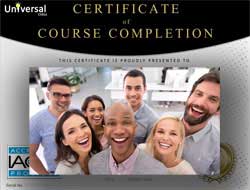Online Class: Basic Math 101

-
12Lessons
-
29Exams &
Assignments -
17Hours
average time -
1.7CEUs
Course Description
Mastering Basic Mathematics: A Comprehensive Guide
Mathematics is an indispensable skill that plays a crucial role in our daily lives. From calculating expenses to determining time schedules or even cooking, basic mathematical knowledge helps us navigate numerous life situations. Yet, many find themselves intimidated by numbers or lost in the maze of operations. Our aim is to ensure that every student walks away with a clear understanding and a renewed confidence in their ability to handle foundational mathematical problems.
Current research indicates that a significant number of adults experience math anxiety, with some sources pointing out that nearly 1 in 5 adults in the U.S. are considered 'innumerate,' struggling with basic mathematical concepts. Whether you've felt the pangs of such anxiety or are simply looking for a refresher course, this comprehensive program is designed for you.
Why This Course?
Whether you're:
- Facing Current Academic Challenges: Battling through a challenging math course?
- Transitioning in Your Career: Stepping into a job that requires solid math proficiency?
- Simply Curious: Wishing to review, refresh, or extend your mathematical horizons?
This course offers tailored content that breaks down complex ideas into digestible modules, backed by practical examples that make learning both engaging and effective.
Prerequisites: While no previous formal education is necessary, it's beneficial if students possess a reading comprehension at or above a 7th-grade level to ensure smooth progression through the material.
Course Breakdown:
-
Numbers and Terminology: Dive into the language of mathematics, understand its syntax, and familiarize yourself with key terms.
-
Addition: The building block of arithmetic. Explore the nuances, techniques, and real-world applications.
-
Subtraction: More than just taking away. Understand its role in finance, time management, and more.
-
Multiplication: Unravel the intricacies of this operation through practical examples from areas like area calculation and data analysis.
-
Division: From sharing to partitioning resources, explore division's real-world relevance.
-
Signs used in Operations: Grasp the interplay of positive and negative numbers in operations, vital for tasks such as financial management and temperature measurement.
-
Operations and Properties: Dive deeper into the structure and laws governing arithmetic, laying a foundation for more advanced math.
-
Fractions: Often feared, yet immensely practical. Understand the concept behind fractions and their everyday implications, like cooking or carpentry.
-
Decimals & The Decimal Number System: From money to measurements, decimals are everywhere. Master their usage and conversion techniques.
-
Percentages: From shopping discounts to interest rates, percentages play a pivotal role in daily life. Learn to calculate, convert, and apply them proficiently.
-
Other Operations: Cover additional mathematical tools and techniques, ensuring a well-rounded arithmetic foundation.
-
Calculators: In today's digital age, calculators are ubiquitous. Learn to harness their power effectively, ensuring accuracy and efficiency.
Unique Features:
Each lesson is accompanied by videos, assignments, exams, and supplementary materials, including netlinks, polls, surveys, and documents, offering a multifaceted learning experience. These materials bolster understanding, providing both theoretical knowledge and practical application.
Conclusion:
In a world increasingly driven by data and numbers, foundational math skills are more important than ever. This course, structured with clarity and precision, ensures that you not only understand basic mathematical concepts but can apply them confidently in real-life scenarios. Join us on this enlightening journey and turn your mathematical apprehensions into a strength!
- Business
- Business Ethics Courses
- Harassment Prevention Courses
- Human Resources Certifications
- Management
- Aromatherapy Courses
- Caregiver Courses
- Career Development Courses
- Communications Courses
- Confidence and Self Esteem Courses
- Healing
- Human Anatomy Courses
- Medical Skills
- Health & Medicine
- Nutrition
- Marketing
- Microsoft Office Certification Courses
- Life Coaching Courses
- Self-Improvement
- Small Business Certifications
- Safety
- Writing Improvement
- Business Writing Courses
Course Lessons
Lesson 1. Understanding One-to-One Correspondence in Everyday Contexts
 Lesson 1 Video A
Lesson 1 Video A
 Lesson 1 Video B
: How to Take an Exam
Lesson 1 Video B
: How to Take an Exam
 Lesson discussions: Math Phobia; Reasons for Taking this Course
Lesson discussions: Math Phobia; Reasons for Taking this Course Assessment: Quiz for Lesson 1 - Numbers and Terminology
Assessment: Quiz for Lesson 1 - Numbers and Terminology Assessment: Lesson 1 Exercises
Assessment: Lesson 1 Exercises
Lesson 2. Discovering the Fundamentals of Addition: From Number Lines to Grouping
 Lesson 2 Video
Lesson 2 Video Review 9 Practice Worksheets
Review 9 Practice Worksheets Complete: Lesson 2 Activity
Complete: Lesson 2 Activity Assessment: Quiz for Lesson 2 - Addition
Assessment: Quiz for Lesson 2 - Addition Assessment: Lesson 2 Exercises
Assessment: Lesson 2 Exercises
Lesson 3. Subtraction Basics
 Lesson 3 Video
Lesson 3 Video Review 9 Practice Worksheets
Review 9 Practice Worksheets Complete: Lesson 3 Activity
Complete: Lesson 3 Activity Assessment: Quiz for Lesson 3 - Subtraction
Assessment: Quiz for Lesson 3 - Subtraction Assessment: Lesson 3 Exercises
Assessment: Lesson 3 Exercises
Lesson 4. Exploring the Dynamics of Multiplication Through Grouping
 Lesson 4 Video
Lesson 4 Video Review 9 Practice Worksheets
Review 9 Practice Worksheets Complete: Lesson 4 Activity
Complete: Lesson 4 Activity Assessment: Quiz for Lesson 4 : Multiplication
Assessment: Quiz for Lesson 4 : Multiplication Assessment: Lesson 4 Exercises
Assessment: Lesson 4 Exercises
Lesson 5. Understanding the Inverse of Multiplication
 Lesson 5 Video
Lesson 5 Video Review 10 Practice Worksheets
Review 10 Practice Worksheets Complete: Lesson 5 Activity
Complete: Lesson 5 Activity Assessment: Quiz for Lesson 5 - Division
Assessment: Quiz for Lesson 5 - Division Assessment: Lesson 5 Exercises
Assessment: Lesson 5 Exercises
Lesson 6. Positive and Negative Numbers: A Comprehensive Overview
 Lesson 6 Video
Lesson 6 Video Review 8 Practice Worksheets
Review 8 Practice Worksheets Lesson discussions: Positives and Negatives
Lesson discussions: Positives and Negatives Complete: Lesson 6 Activity
Complete: Lesson 6 Activity Assessment: Quiz for Lesson 6 - Signs used in Operations – Positive and Negative Numbers
Assessment: Quiz for Lesson 6 - Signs used in Operations – Positive and Negative Numbers Assessment: Lesson 6 Exercises
Assessment: Lesson 6 Exercises
Lesson 7. The Complexity Behind Whole Numbers: Closure and Beyond
 Lesson 7 Video
Lesson 7 Video Review 5 Practice Worksheets
Review 5 Practice Worksheets Assessment: Quiz for Lesson 7 - Operations and Properties
Assessment: Quiz for Lesson 7 - Operations and Properties Assessment: Lesson 7 Exercises
Assessment: Lesson 7 Exercises
Lesson 8. Mastering the Art of Fractions: Discovery through Division
 Lesson 8 Video
Lesson 8 Video Review 6 Practice Worksheets
Review 6 Practice Worksheets Assessment: Quiz for Lesson 8 - Fractions
Assessment: Quiz for Lesson 8 - Fractions Assessment: Lesson 8 Exercises
Assessment: Lesson 8 Exercises
Lesson 9. The Basics of Base Ten Arithmetic
 Lesson 9 Video
Lesson 9 Video Review 5 Practice Worksheets
Review 5 Practice Worksheets Assessment: Quiz for Lesson 9 - Decimals/The Decimal Number System
Assessment: Quiz for Lesson 9 - Decimals/The Decimal Number System Assessment: Lesson 9 Exercises
Assessment: Lesson 9 Exercises
Lesson 10. From Fractions to Finance: Mastering Percent Calculations for Daily Life
 Lesson 10 Video
Lesson 10 Video Review 6 Practice Worksheets
Review 6 Practice Worksheets Assessment: Quiz for Lesson 10 - Percentages
Assessment: Quiz for Lesson 10 - Percentages Assessment: Lesson 10 Exercises
Assessment: Lesson 10 Exercises
Lesson 11. Mastering Rounding: A Dive into Significant Digits
 Lesson 11 Video
Lesson 11 Video Complete: Lesson 11 Activity
Complete: Lesson 11 Activity Assessment: Quiz for Lesson 11 - Other Operations
Assessment: Quiz for Lesson 11 - Other Operations
Lesson 12. Mastering Your Mobile Calculator: A Visual Guide
 Lesson 12 Video
Lesson 12 Video Review 5 Practice Worksheets
Review 5 Practice Worksheets Lesson discussions: Using Calculators; Program Evaluation Follow-up Survey (End of Course); Course Comments
Lesson discussions: Using Calculators; Program Evaluation Follow-up Survey (End of Course); Course Comments Assessment: Quiz for Lesson 12 - Calculators : Using a Calculator
Assessment: Quiz for Lesson 12 - Calculators : Using a Calculator Assessment: The Final Exam
Assessment: The Final Exam
Learning Outcomes
- Define and explain the differences between rational and irrational numbers, using examples of each.
- Identify and demonstrate one-to-one correspondence using objects and numbers on a number line.
- Analyze a vertical addition problem to demonstrate understanding of column alignment and carrying when sums exceed ten.
- Define the terms 'addend,' 'sum,' and 'plus sign' and illustrate their use in simple addition scenarios.
- Define and apply the terms minuend, subtrahend, and difference to solve subtraction problems involving two-digit numbers.
- Demonstrate the ability to use number lines to perform and verify subtraction operations for values up to 20.
- Define multiplication as a process of adding equal groups and identify factors, multiplicand, and multiplier in given multiplication problems.
- Demonstrate multiplication using both single and multi-digit numbers, and apply the use of place value alignment and carrying for accuracy.
- Apply divisibility rules to determine if a number is divisible by 2, 3, 4, 5, 6, and 9.
- Identify and calculate the quotient and remainder in division problems involving a dividend and single-digit divisor.
- Demonstrate the ability to perform arithmetic operations involving positive and negative numbers and apply rules for addition, subtraction, multiplication, and division.
- Recognize and correctly identify positive and negative numbers on a number line and determine their relative positions.
- Recognize the closure property of whole numbers under addition and multiplication but not under subtraction and division.
- Demonstrate mastery of lesson content at levels of 70% or higher.
Additional Course Information

- Document Your Lifelong Learning Achievements
- Earn an Official Certificate Documenting Course Hours and CEUs
- Verify Your Certificate with a Unique Serial Number Online
- View and Share Your Certificate Online or Download/Print as PDF
- Display Your Certificate on Your Resume and Promote Your Achievements Using Social Media

Student Testimonials
- "Wow, this class really made me use my brain. It also made me realize that watching the lesson videos in a math class is super important because just reading the material and not seeing examples is not very easy. Thanks for the refresher." -- Stephanie A.
- "I thought this was a very helpful course and I enjoyed relearning things and learning things I didn't quite get the first time. Thank you for this course I appreciate this." -- Josh B.
- "I felt like it was extremely helpful and exactly what I was looking for. The lessons were great and the option to spend time doing worksheets on anything I needed extra help with was perfect. Sometimes just the lesson alone was enough and sometimes I needed the confidence of working some of the practice problems, I liked that I had the options." -- Heather P.
- "The instructor provided Feedback. The lesson plans were well organized. There were plenty of practice problems. I would definitely take another class that this instructor is teaching." -- Shirley A.
- "The instructor was very professional, presented herself well, and was kind to me especially when expressing her kudos to my lessons well done." -- Marie line J.
- "The instructor was very helpful, and provided excellent feedback. She allowed me to retake an exam when I had problems, after I reviewed the material again." -- Judith J.
- "They answered my questions and the course helped me get a better grip on mathematics basics and it will be helpful in the future." -- Justine C.
- "She is amazing and responded quickly to my questions." -- Heaven B.
- "She is really the best! Helpful and gives positive feedback back all the time!" -- Janmarie D.
- "The instructor was always very patient, responded very quickly with the feedback." -- Karen M.










